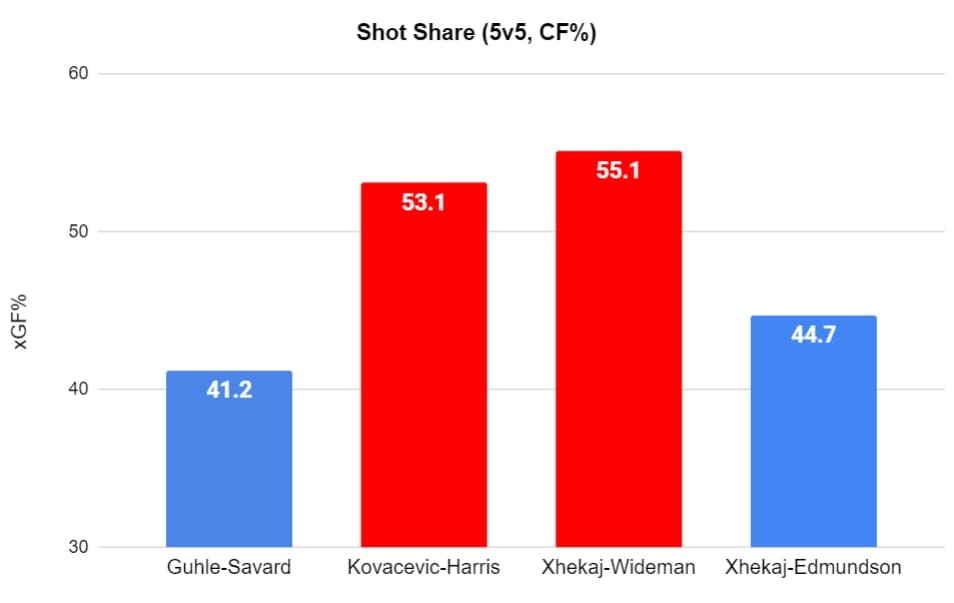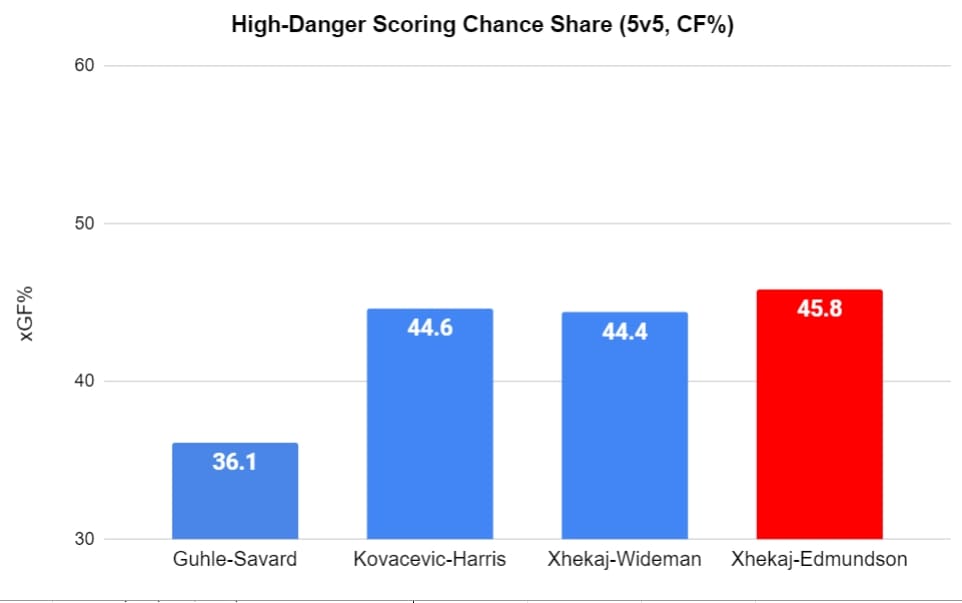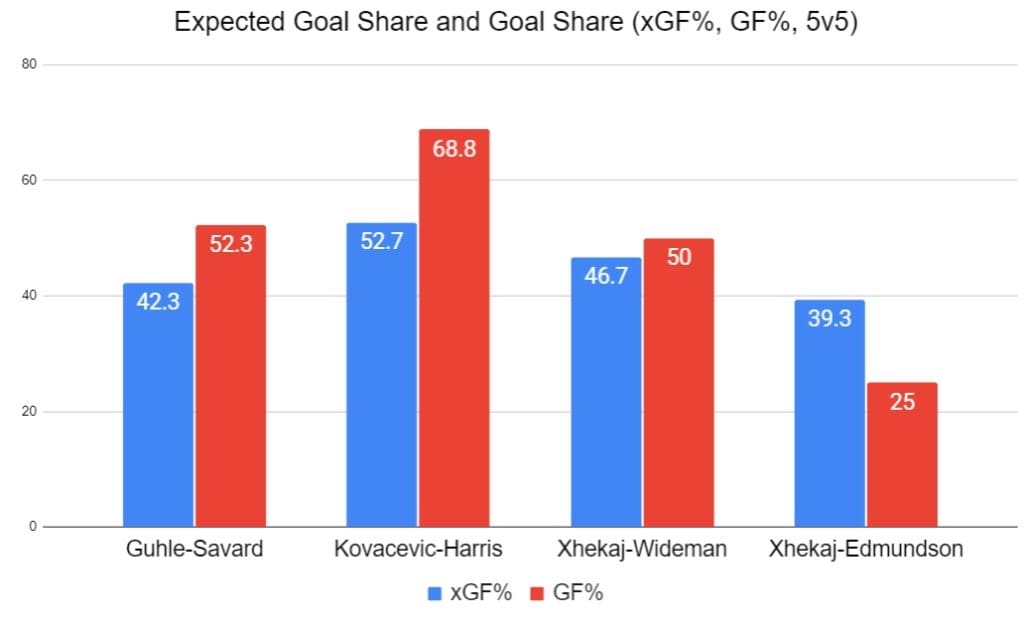Montreal Canadiens
Projecting Canadiens Defensive Pairings With Matheson: Who Sits

As veteran defenceman Mike Matheson nears a return to play, the Canadiens have a major decision on their hands regarding the potential defensive pairings.
Statistically speaking, Matheson is the Canadiens’ best defenceman, and therefore another change in the defensive lineup is on the horizon.
To get a better sense of which pairing is performing up to snuff, and which pairing could use some help, we’ll take a closer look at their overall performances since the start of the season.
By The Numbers (5v5)
The Canadiens have primarily relied on four different pairings this season. The Kaiden Guhle and David Savard pairing has been used most often by head coach Martin St-Louis, over 200 minutes a 5v5, making them one of the busiest pairings in the entire NHL.
The Jordan Harris and Johnathan Kovacevic pairing is approaching the 200-minute mark, whereas Arber Xhekaj has spent time alongside both Chris Wideman and Joel Edmundson.
When it comes to their ability to control shots while they’re on the ice, there are only two pairings that have managed to fall on the right side of 50 percent.

Of course, we must keep in mind Guhle and Savard tend to face the opposing team’s best players, but it’s worth noting Harris and Kovacevic also face a relatively high level of competition.
Xhekaj and Wideman on the other hand, tend to be sheltered, which was also the case when Edmundson was placed alongside Xhekaj. The results between both veteran defencemen are staggering, as the third pairing controls over 10 percent fewer shots when Edmundson is added to the mix.
High-Danger Chances (HDCF%)
The biggest issue the Canadiens have to address from a defensive standpoint is the volume of high-danger chances they allow every night.
They’ve only managed to control 42.7 percent of the chances, however, they have been doing a much better job lately. For example, against the Pittsburgh Penguins, they held a 73% advantage in high-danger shots (11-4), their best result of the season.
But as you can see in the chart below, every single pairing falls on the wrong side of 50 percent this season.

The second and third pairings have produced very similar numbers, whereas the top pairing has struggled mightily while facing the opposing team’s best forwards.
Expected Goal Share (xGF%)
To get a better idea of their overall play, we can take a look at their expected goal share (xGF%) as well as their actual goal share (GF%).
Despite struggling to control shots and scoring chances, the top pairing has managed to stay on the right side of 50 percent in goal share.
But their expected goal share is much lower, pointing to the possibility that a significant drop in overall goal share may be on its way.

On the other hand, the Kovacevic and Harris pairing has controlled both the goals and the expected goals, which is consistent with the eye test. It’s rather difficult to remember many of their shifts that involved sustained pressure by opposing teams in the Canadiens’ defensive zone.
As for the Xhekaj experiment, it’s clear that overall, Wideman has yielded better results alongside the rookie.
Brass Tacks
The numbers look rather harsh in Edmundson’s case, though not overly surprising given his results in the last two seasons.
But we also must be mindful that Edmundson is still dealing with some rust due to the back injury that kept him out of the lineup earlier this season.
However, it’s impossible to ignore that when he’s on the ice the Canadiens tend to be outshot, outchanced, and outscored.
Except for outscoring their opponents, the same is true in the case of the top pairing, but again, Guhle and Savard have been facing the Sidney Crosbys, Alex Ovechkins and Auston Matthews’ of the NHL, which makes their results a little more palatable.
If there’s one pairing that absolutely shouldn’t be modified, it’s clearly the Harris and Kovacevic combination.
Yes, they’re rookies and yes they’re outperforming their projections, but the fact of the matter is they have been the Canadiens’ best pairing in almost every key statistical category, both in terms of projections and results.
Ideally, Martin St-Louis would avoid disassembling his best duo and focus on the other options, because there’s definitely room for improvement on the 1st and 3rd pairings.
A Guhle and Matheson pairing would likely yield numbers that are a little closer to what you’d expect from a top pairing, though it must be said that Guhle has already received an overabundance of minutes.
The Canadiens would be wise to manage his workload, especially since he’s also tasked with playing on the penalty kill.
With that in mind, slotting Savard on the third pairing alongside Xhekaj would allow St-Louis to use the bottom pairing a little more often, which should alleviate the pressure on the top pairing and also keep Savard in the mix when opponents receive a power play.
It may be harsh, and it may be a little too early to make the call given he’s only played five games this season, but all signs point to Edmundson being the most logical candidate to sit once Matheson returns.
(All Montreal Canadiens statistics are 5v5 unless otherwise noted, via NaturalStatTrick)









